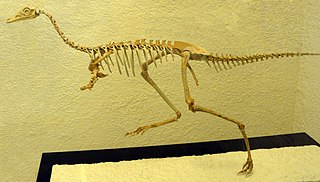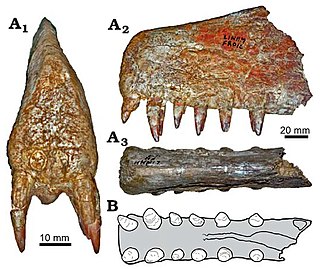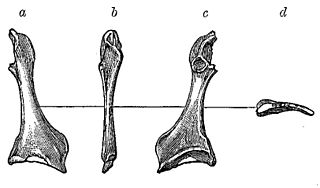
Charadriiformes is a diverse order of small to medium-large birds. It includes about 390 species and has members in all parts of the world. Most charadriiform birds live near water and eat invertebrates or other small animals; however, some are pelagic (seabirds), others frequent deserts, and a few are found in dense forest. Members of this group can also collectively be referred to as shorebirds.

Struthionidae is a family of flightless birds, containing the extant ostriches and their extinct relatives. The two extant species of ostrich are the common ostrich and Somali ostrich, both in the genus Struthio, which also contains several species known from Holocene fossils such as the Asian ostrich. The common ostrich is the more widespread of the two living species, and is the largest living bird species. Other ostriches are also among the largest bird species ever.

Laridae is a family of seabirds in the order Charadriiformes that includes the gulls, terns, skimmers and Kittiwakes. It includes around 100 species arranged into 22 genera. They are an adaptable group of mostly aerial birds found worldwide.

Achillobator is a genus of large dromaeosaurid dinosaur that lived in Asia during the Late Cretaceous period about 96 million to 89 million years ago in what is now the Bayan Shireh Formation. The genus is currently monotypic, only including the type species A. giganticus. The first remains were found in 1989 during a Mongolian-Russian field expedition in Mongolia and later described in 1999. Remains at the type locality of Achillobator may represent additional specimens. It represents the first and largest dromaeosaurid known from the Bayan Shireh Formation.

The Hell Creek Formation is an intensively studied division of mostly Upper Cretaceous and some lower Paleocene rocks in North America, named for exposures studied along Hell Creek, near Jordan, Montana. The formation stretches over portions of Montana, North Dakota, South Dakota, and Wyoming. In Montana, the Hell Creek Formation overlies the Fox Hills Formation. The site of Pompeys Pillar National Monument is a small isolated section of the Hell Creek Formation. In 1966, the Hell Creek Fossil Area was designated as a National Natural Landmark by the National Park Service.

Mononykus is a genus of alvarezsaurid dinosaur that lived during the Late Cretaceous in what is now Asia on the Nemegt Formation, about 70 million years ago.

Presbyornithidae is an extinct group of birds with a global distribution. They had evolved by the late Cretaceous period and became extinct during the early Miocene. Initially, they were believed to present a mix of characters shown by waterbirds, shorebirds and flamingos and were used to argue for an evolutionary relationship between these groups, but they are now generally accepted to be waterfowl closely related to modern ducks, geese, and screamers.

Siroccopteryx is an extinct genus of anhanguerid pterodactyloid pterosaur, known from middle Cretaceous sediments in modern-day Morocco. Some researchers, such as David M. Unwin, consider the genus a junior synonym of Coloborhynchus.

Phosphatodraco is a genus of azhdarchid pterosaur from the Late Cretaceous of Morocco. The type and only known species is Phosphatodraco mauritanicus. Phosphatodraco was a moderate-sized azhdarchid, with an estimated wingspan of about 5 meters. It is based on a string of neck vertebrae from the phosphate beds of the Ouled Abdoun Basin, in sediments from the very end of the Cretaceous. It was the first pterosaur to be named from the phosphate beds, though many more named and unnamed species have been discovered since Phosphatodraco was first described in 2003.

Lonchodectidae or Lonchodraconidae is a group of pterosaurs within the clade Pterodactyloidea. It has variously been considered to be within Ctenochasmatoidea, Azhdarchoidea and Pteranodontia. They are notable for their high, conical tooth sockets and raised alveolar margins.

Aralazhdarcho is a genus of azhdarchid pterosaur from the Santonian to the early Campanian stages of the Late Cretaceous period of Bostobe Svita in Kazakhstan. The type and only known species is Aralazhdarcho bostobensis.

Cretornis is a pterosaur genus from the late Cretaceous period of what is now the Jizera Formation in the Czech Republic, dating to about 92 million years ago. It only contains a single species, Cretornis hlavaci.

Cimolopteryx is a prehistoric bird genus from the Late Cretaceous Period. It is currently thought to contain only a single species, Cimolopteryx rara. The only specimen confidently attributed to C. rara was found in the Lance Formation of Wyoming, dating to the end of the Maastrichtian age, which ended about 66 million years ago. The dubious species "Cimolopteryx" maxima has been described from both the Lance Formation and the Hell Creek Formation of Montana. The humeral end of a left coracoid from the Frenchman Formation of southern Saskatchewan has also been attributed to the genus.
Palaeotringa is a prehistoric bird genus that was discovered by O. C. Marsh during the late 19th century American bone wars. Its remains were found in the controversial Hornerstown Formation of New Jersey which straddles the Cretaceous-Paleocene boundary some 66 million years ago. Though it cannot be said if these birds lived before or after the Cretaceous–Paleogene extinction event, they were in all likelihood wading birds that inhabited the coasts of the northwestern Atlantic.
Graculavus is a prehistoric bird genus that was described in the 19th century by American paleontologist O. C. Marsh. Its remains were found in the Late Cretaceous Austin Chalk of Texas, USA, and Lance Formation, and the controversial Hornerstown Formation which straddles the Cretaceous–Paleocene boundary, possibly dating to the Danian stage. These birds lived on the shores of the northwestern Atlantic and the Western Interior Seaway some 68 to 62 million years ago.
Sultanuvaisia is an extinct genus of ichthyodectiform teleost ray-finned fish from the Late Cretaceous of Kyzyl Kum, central Asia. It was named by Lev Nesov in 1981. At first, he tentatively described the fossil material as jaw fragments of a ctenochasmatid pterosaur, but reinterpreted Sultanuvaisia as a fish in 1986. The type species is S. antiqua.

Lithornithidae is an extinct, possibly paraphyletic group of early paleognath birds. They are known from fossils dating to the Upper Paleocene through the Middle Eocene of North America and Europe, with possible Late Cretaceous representatives. All are extinct today; the youngest specimen is the currently unnamed SGPIMH MEV1 specimen from the mid-Eocene Messel Pit site.

Germanodactylidae is a controversial group of pterosaurs within the suborder Pterodactyloidea. It was first named by Yang Zhongjian in 1964, and given a formal phylogenetic definition in 2014 by Brian Andres, James Clark, and Xu Xing. They defined it as the least inclusive clade containing Germanodactylus cristatus and Normannognathus wellnhoferi, which they considered to be close relatives at the time. However, more recent studies by the same researchers have found that these pterosaurs may be only distantly related.

Acheroraptor is an extinct genus of dromaeosaurid theropod dinosaur known from the latest Maastrichtian Hell Creek Formation of Montana, United States. It contains a single species, Acheroraptor temertyorum. A. temertyorum is one of the two geologically youngest known species of dromaeosaurids, the other being Dakotaraptor, which is also known from Hell Creek. A basal cousin of Velociraptor, Acheroraptor is known from upper and lower jaw material.

Draigwenia is an extinct genus of pterosaur known from a jaw fragment found in the Late Cretaceous Cambridge Greensand in the United Kingdom. The fossil was likely reworked from an Early Cretaceous layer that can be dated to the Albian. It currently contains a single species, Draigwenia platystomus.



















